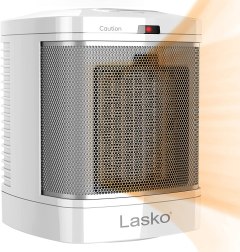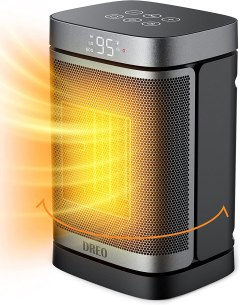
A stylish, bladeless design that delivers room-filling warmth with welcome safety features.
A stylish, bladeless design that delivers room-filling warmth with welcome safety features.
Bladeless design mixes ambient air via heat channels for long-range heating. Includes tip-over detection as well as cool-touch housing and self-regulating ceramic element. 1,500-watt heater outputs 5,100 BTUs. Programmable thermostat. Sleek, small footprint.
A bit pricey. Not the most powerful heating in its class.

Despite a finicky tip-over switch, this is an affordable, no-frills heater that can quickly warm up a room.
Despite a finicky tip-over switch, this is an affordable, no-frills heater that can quickly warm up a room.
Your choice of silver or black. Comes with fan, low, or 1,500-watt high settings. Features adjustable thermostat. Tip-over and overheat safety features. Small in size, but can quickly heat a small room. Decent price.
Sensitive tip-over switch accidentally activates on carpet.

Safety features are paramount in this bathroom-friendly heater design.
Safety features are paramount in this bathroom-friendly heater design.
The ACLI safety plug shuts off current within instants of a short. A 3-level heater runs at 1,500 watts on maximum. Offers 1-hour timer and 1-button max heat program. Includes overheat protection and cool-touch housing. Compact and portable.
Doesn't have tip-over detection.

Small, sleek, and attractive, this personal heater won't look shabby next to your desk.
Small, sleek, and attractive, this personal heater won't look shabby next to your desk.
Quiet operation at 40 decibels, softer than normal conversation. Has 4 modes including fan, eco, low (900 watts), and high (1,500 watts.) It Oscillates 70 degrees for good coverage. Offers tip-over detection and overheating safety.
Small size is designed for personal heating only.

Admirable performance and power in a design inspired by a famous landmark.
Admirable performance and power in a design inspired by a famous landmark.
Angled tilt directs heat higher than horizontal units. Outputs 5200 BTUs from up to 1500 watts. Boasts ability to heat up to 70º F in just 3 seconds. Simple controls with three settings. Offers tip-over protection and cool-touch housing.
Lacks a true thermostat. Does not offer a timer.

We recommend these products based on an intensive research process that's designed to cut through the noise and find the top products in this space. Guided by experts, we spend hours looking into the factors that matter, to bring you these selections.

If you want to stay warm in the winter without cranking up the thermostat, a space heater is a valid option. Ceramic space heaters are especially popular because they can quickly heat an entire room and are known for being durable. And because they can efficiently self-regulate temperature, ceramic heaters are considered to be a fairly safe choice.
However, that doesn’t mean that one ceramic heater is as good as the next. Various products have different features, safety settings, and heat output. It’s important to understand all of your options before purchasing a ceramic heater.

The most important factors to consider when choosing a ceramic heater are safety, size, and heater type.
Modern space heaters are much safer than their older counterparts, but you still should exercise caution. Choose a ceramic heater that has been certified by an independent testing agency like Underwriters Laboratory (UL). The best ceramic heaters have built-in overheat protection that automatically shuts off the heater if it exceeds a safe temperature. Some units have tip-over protection as well, which shuts off the heater if it falls over.
Households with animals or small children should opt for a unit that has a cool-touch housing. Otherwise, someone could accidentally burn themselves by coming into contact with the outside of the heater.
How large is the space you wish to heat with a ceramic heater? Be sure to choose a model that’s sized appropriately. Obviously, larger rooms will require higher heat output, but there are other factors to consider as well. If your home is drafty, for example, you may need a more powerful ceramic heater to combat the cold air seeping in. Generally speaking, you should plan on needing about 10 watts of power for every square foot of space. So if your goal is to heat a 100-square-foot room, you would need a 1,000-watt ceramic heater.
Ceramic heaters are available in three main types: floor, tower, and wall. Floor ceramic heaters are what most people think of when they picture a traditional space heater. These compact units sit on the ground and put out heat in all directions. They’re usually lightweight and portable, but it all depends on the size of the heater you choose.
Tower heaters are tall and thin — a great choice for tight spaces. Some have an oscillation feature that rotates the unit back and forth, evenly dispersing heat throughout the room.
Wall ceramic heaters are usually permanent installations that must be wired into the wall. Some people choose to place them in select rooms of the home, such as the bathroom, for supplemental heat. If you don’t own your home, however, the installation of a wall ceramic heater may not be an option.
Before you buy a ceramic heater, check out its thermostat. Some ceramic heaters have a single heat setting or simple low, medium, and high settings. Others let you select the precise degree of heat that you want. Some thermostats give you the option of pre-programming your desired temperature. If the room drops below this temperature, the thermostat will turn on automatically and continue to run until your desired temperature is achieved.
Some ceramic heaters have timers. You can program these units to run for a certain period of time and then shut off — a nice option if you’re prone to forgetting to turn your heater off before bed or before you leave the house.
Some ceramic heaters include a remote so you can adjust the settings from across the room. Not everyone will want this, but it’s a handy feature to have, especially for those with limited mobility.
All space heaters use some electricity, but how much depends on the size of the unit. Larger units require more electricity to run, so you can expect a larger energy bill. How often you use the heater is also a factor. Some ceramic heaters have an energy-saving mode to help cut costs.
If you plan to move the ceramic heater around the room with you, opt for a model that has a handle on top so you can pick it up easily. For larger heaters, you may also want a unit with wheels so you can push it without lifting. Cord length is important to consider, too. Think about where the outlets are in your home and where you want to put the space heater.
Some space heaters are louder than others, and you may find a loud space heater to be distracting. If this is a concern for you, be sure to select a quality space heater with a reputation for low noise output.
Most ceramic heaters for home use range in price from $20 to $100.
If you just need a compact unit to heat a small space, you could probably get by with spending less than $50. Plenty of durable units exist in this price range, including some with programmable thermostats, remotes, and other advanced features.
Larger ceramic heaters, including tower heaters, cost a bit more: most start around $50. These heaters are more powerful and often have advanced options, such as a built-in timer and oscillation, to help spread heat evenly.
Never leave your ceramic heater on when you leave the house or go to bed.
Keep the area around your ceramic heater clear, and don’t point the heater directly at anything flammable.
Do not plug large ceramic heaters into extension cords or power strips.
Don’t use ceramic heaters around water or in damp areas (like a bathroom) unless the unit is specifically designed for it.
Check the cord periodically to make sure the wires are not exposed or frayed.

A. Metal coils are surrounded by ceramic plates. When the heater is plugged in, the coils heat up, which in turn heats up the plates. The unit then releases the heat into the room. Because the metal coils are not exposed, the ceramic heater housing is able to stay cooler, so there is minimal risk of burns.
A. No. Ceramic heating elements are known for being extremely durable, so you shouldn’t need to do anything to the heater aside from vacuuming dust out of the vents periodically.
A. There are several factors that influence this, including the wattage of the heater, the cost of electricity in your area, and how often you use the heater. To estimate this amount, take the wattage of the heater and divide it by 1,000 to get the kilowatts per hour. Then, to determine a total, multiply this number by the number of hours the heater is in use and the cost of one kilowatt of electricity in your area.
Get emails you’ll love.
Learn about the products you’re wondering if you should buy and get advice on using your latest purchases.
